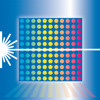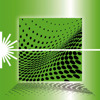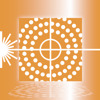 |
Daten-
blatt:
 |
APP N° 686
Param.:
 |
INI:
 |
|
Séparation des couleurs de pièces métalliques
Des particules métalliques doivent être séparées en fonction de leur couleur.
Color separation of metal parts
Metal parts should be separated depending on the color.
|

|
 |
Daten-
blatt:
 |
APP N° 633
Param.:
 |
INI:
 |
|
Mesure des quantités de suie sur du papier filtre
La quantité de suie sur un papier filtre doit être déterminée.
Soot quantity measurement on filter paper
The amount of soot on filter paper should be measured.
|

|
 |
Daten-
blatt:
 |
APP N° 413
|
Contrôle d’orientation de fils métallique sur un film plastique transparent
La position de la face arrière / avant côté de fils métalliques sur un film plastique transparent doit être détrompée.
Position monitoring of metal wires on a transparent plastic layer
The back side / front side position of metal wires on a transparent plastic film should be controlled.
|

|
 |
Daten-
blatt:
 |
APP N° 246
|
Mesure de la brillance du revêtement primaire sur une pale de turbine d’éolienne
Le facteur de brillance du revêtement primaire d’une pale de turbine d’éolienne doit être mesuré sans contact. A cet effet, un capteur de brillance est monté sur un robot et est maintenu à une distance de 15 mm de la surface primaire. La pale de turbine d’éolienne est simultanément déplacée à l’horizontal en dessous du capteur de brillance. Le degré de brillance doit normalement adopter une valeur inférieure à 5 afin que le revêtement suivant la couche primaire ait une bonne adhérence avec ce dernier.
Gloss measurement of the primer surface on a vane
The gloss factor of the primer surface of vanes from wind turbines should be measured contactless. At this, the gloss sensor is mounted on a robot and will be moved vertically to make sure, that the distance to the primer surface of the vane remains approximately at 15mm, simultaneously the vane will be moved horizontally so that the gloss factor can be measured along the long axis of the vane. Normally the gloss factor of the primer surface should be lower than 5 in order to guarantee that the following coating get a fix compounding to the primer surface.
|

|
 |
Daten-
blatt:
 |
APP N° 185
|
Mesure de la brillance de la surface en verre d’un panneau photovoltaïque
Le degré de brillance du recouvrement de verre d’un panneau photovoltaïque doit être mesuré pendant la production.
Gloss measurement of the glass surface of a photo voltaic panel
The gloss factor of the glass cover of a photo voltaic panel should be measured during the production.
|

|
 |
Daten-
blatt:
 |
APP N° 150
|
Contrôle des eaux usées et classification
Les eaux usées doivent être contrôlées et classifiées. A cet effet, on pourrait envisager de poser des verres de regard à travers lesquels on peut mesurer, ou bien prévoir une immersion directe dans le bain des eaux usées.
Waste water detection and classification
Waste water should be detected, controlled and classified. For this purpose sight glasses can be used for the measurement or even dipping the optical front end unit into the waste water is also possible.
|

|
 |
Daten-
blatt:
 |
APP N° 98
|
Analyse du taux d’huile dans le recyclage d’eau usée
La quantité d’huile est de 500ppm dans les eaux usées alors que l’objectif est d’atteindre 5 fois moins. La mesure de l’effet fluorescent des huiles permet cette quantification.
Oil containing waste water detection
On an oil press the amount of oil in the waste water must be controlled. Typical values are 500ppm of flux oil in the waste water and the goal is to reach the 100ppm. At this the fluorescent effect of the flux oil can be used.
|

|
 |
Daten-
blatt:
 |
APP N° 73
|
Reconnaissance couleur de céllules pour panneaux solaires
La répétabilité de la couleur bleue doit être controlée dans les ligne de fabrication et d’assemblage pour panneau solaires.
Color differentiation of solar photo cells
The blue color of solar photo cells can differ due to the production process from factory to factory and even from line to line in the same factory. Thus, the color of the solar photo cells should be controlled.
|

|
 |
Daten-
blatt:
 |
APP N° 54
|
Contrôle du flux de soudage pendant son application
Dans la fabrication de circuits imprimés, les zones à souder doivent être enduites d’un flux. Les buses générant un filet de quelques dixièmes de diamètre, il est necessaire d’analyser la quantité et l’angle de pulvérisation.
Soldering flux control during the selective flux application
Selective soldering in combination with selective flux application becomes more and more popular. Especially manufacturers of mixed assembled PCB boards benefit from this new technology. Only the areas which will be soldered will be covered from the soldering flux. To achieve this, a piezo nozzle is used to generate small flux droplets with a diameter of a few tenth of a millimeter. At this the scattering angle is very small which make sure, that the droplets strike only the scheduled area. The amount as well as the direction of the droplets should be controlled.
|

|
 |
Daten-
blatt:
 |
APP N° 50
|
Contrôle couleur de la présence de flux
Pendant l’assemblage de cellules photovoltaiques, il est necessaire de controler la présence de flux de soudage.
Color control of the presence or absence of the flux
During the assembling process of photovoltaic cells on a stringer machine the conduction band must be controlled in respect of the presence or absence of the soldering flux.
|

|
 |
Daten-
blatt:
 |
APP N° 23
|
Contrôle de liquide colorés
Pendant les procédés exoloitant de l’eau il est necessaire de controler la qualité.L’eau peut devenir bleutée (polution) ou jaunir (huile), qui détectée necessitera le nettoyage.
Colored liquid control
During a water cycle process the quality of the water must be controlled. It can happen that the water becomes slightly blue (pollution) or beige (oily) in color. Both case must be detected, the water must be clean.
|

|